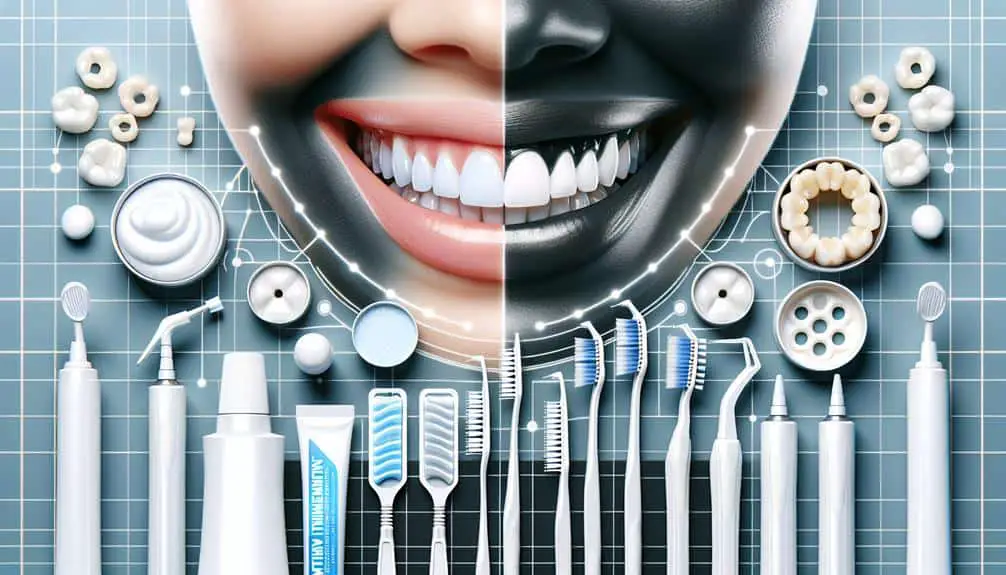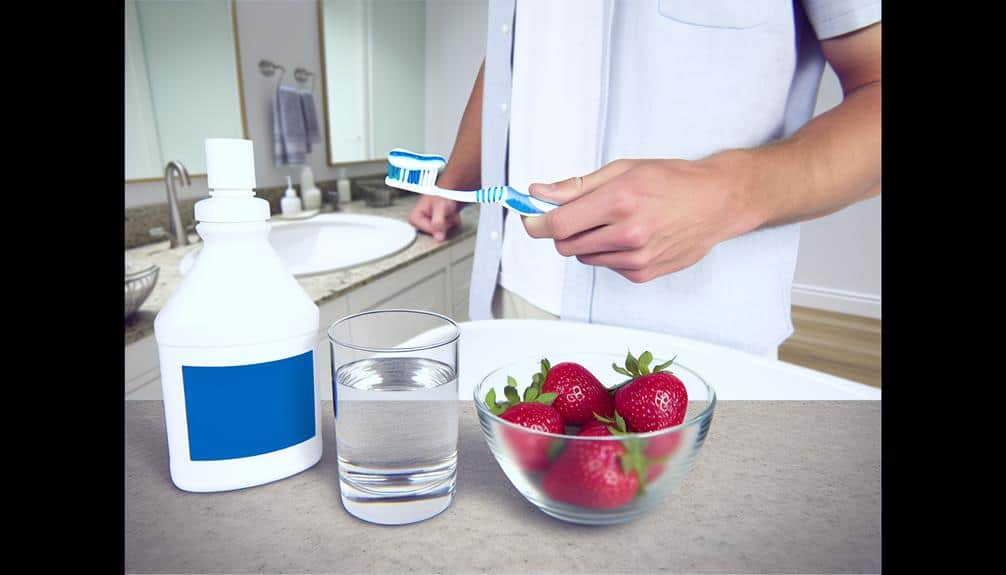Brighten your smile at home with natural remedies. Try making a teeth-whitening paste using lemon juice and baking soda for a gentle scrub. Incorporate oil pulling with coconut oil to support oral hygiene. Consider using activated charcoal toothpaste for surface stains. Another option is a strawberries and baking soda paste to potentially brighten teeth. Finally, an apple cider vinegar rinse could help reduce plaque. Each method offers a natural approach to enhancing your pearly whites.
Key Points
- Use lemon juice and baking soda paste for natural whitening.
- Incorporate oil pulling with coconut oil for oral hygiene.
- Try activated charcoal toothpaste to remove surface stains.
- Create a strawberry and baking soda paste for brightening.
- Rinse with diluted apple cider vinegar to reduce discoloration.
Lemon Juice and Baking Soda
To effectively brighten discolored teeth at home, you can create a natural teeth-whitening paste using lemon juice and baking soda. These ingredients are commonly used in DIY techniques for teeth whitening due to their natural remedies. Lemon juice contains citric acid, which has a bleaching effect, while baking soda acts as a mild abrasive that helps scrub away surface stains on teeth.
When combined, lemon juice and baking soda form a paste that can be gently applied to your teeth using a toothbrush or your finger. It's important to note that while this mixture can help brighten teeth, excessive use may erode tooth enamel due to the acidic nature of lemon juice. Hence, it's recommended to use this DIY technique sparingly, perhaps once a week, and always rinse your mouth thoroughly after application.
Additionally, it's advisable to consult with your dentist before trying any at-home teeth-whitening remedies to make sure they're suitable for your dental health.
Oil Pulling With Coconut Oil
Consider incorporating oil pulling with coconut oil into your dental care routine for potential teeth-whitening benefits. Oil pulling is an ancient practice known for its oral hygiene benefits and is believed to help in reducing bacteria and plaque in the mouth. Coconut oil, specifically, is known for its antimicrobial properties, making it a popular choice for oil pulling.
Here are some key points to keep in mind when trying oil pulling with coconut oil:
- Swish a tablespoon of coconut oil in your mouth for about 15-20 minutes each day.
- Spit out the oil into a trash can once you're done to avoid clogging your sink with solidified oil.
- Remember not to swallow the oil as it contains bacteria and toxins that you've just removed from your mouth.
Oil pulling with coconut oil can be a gentle and natural way to support your oral hygiene routine and explore the benefits of natural remedies for teeth whitening.
Activated Charcoal Toothpaste
When exploring options for brightening discolored teeth at home, activated charcoal toothpaste is a product worth considering for its potential whitening effects. Charcoal powder is the key ingredient in these toothpaste formulations. Activated charcoal is known for its absorbent properties, which can help remove surface stains on teeth caused by coffee, tea, or red wine.
Many individuals opt for activated charcoal toothpaste as part of their DIY whitening remedies due to its purported ability to bind to compounds that cause stains on teeth. However, it's important to note that while charcoal toothpaste may help with surface stains, it may not alter the natural color of your teeth or address deeper discoloration issues.
Before incorporating activated charcoal toothpaste into your oral care routine, it's advisable to consult with a dental professional. They can provide guidance on whether this product is suitable for your teeth and offer recommendations tailored to your specific needs. Remember, maintaining good oral hygiene practices alongside exploring whitening options is vital for achieving a brighter smile.
Strawberries and Baking Soda Paste
Exploring natural options for teeth whitening, a paste made from strawberries and baking soda is a popular DIY remedy that some individuals contemplate due to its potential brightening effects. Strawberries contain malic acid, which may help remove surface stains on teeth, while baking soda acts as a gentle abrasive to scrub away discoloration without eroding enamel. To create this paste at home, mash up a ripe strawberry and mix it with a pinch of baking soda until you get a smooth consistency.
Here are some key points to contemplate when using this mixture:
- Gently apply the paste to your teeth using a soft toothbrush.
- Allow the mixture to sit on your teeth for 5-7 minutes before rinsing thoroughly.
- Limit the frequency of this treatment to once a week to prevent any potential damage to your enamel.
Remember to always follow up with your regular dental care routine, including proper dental flossing techniques and reaping the benefits of tongue scraping for overall oral health maintenance.
Apple Cider Vinegar Rinse
To effectively utilize an apple cider vinegar rinse for teeth whitening, dilute the vinegar with water in a 1:2 ratio before swishing it in your mouth for about a minute. Apple cider vinegar contains acetic acid, which has been shown to have antibacterial properties that can help in reducing plaque and whitening teeth. The vinegar benefits extend to its natural ability to remove stains and kill bacteria in the mouth, contributing to a fresher breath and potentially brighter smile.
When using natural remedies like apple cider vinegar for teeth whitening, consistency is key. It's important to remember that while apple cider vinegar can be beneficial, it's acidic and prolonged exposure can erode tooth enamel. Therefore, it's advisable to use this rinse sparingly, perhaps a few times a week, and always make sure it's diluted properly to minimize any potential harm to your teeth.
Incorporating an apple cider vinegar rinse as part of your oral hygiene routine, alongside regular brushing and flossing, can be a natural and cost-effective way to brighten discolored teeth over time. Remember, moderation and proper dilution are essential when using natural remedies for teeth whitening.
Frequently Asked Questions
Are There Any Potential Side Effects or Risks Associated With Using Lemon Juice and Baking Soda to Brighten Discolored Teeth at Home?
When using lemon juice for brightening teeth, be cautious of sensitivity risks. Baking soda can cause abrasion effects if used excessively. Consider these factors when aiming for a brighter smile at home.
How Often Should Oil Pulling With Coconut Oil Be Done in Order to See Noticeable Results in Teeth Whitening?
To see noticeable results in teeth whitening with coconut oil benefits, oil pulling should be done daily for about 10-15 minutes. Consistency is key for achieving desired outcomes. Be mindful of overdoing it to avoid any potential risks.
Is It Safe to Use Activated Charcoal Toothpaste on a Daily Basis, and Are There Any Long-Term Effects to Be Aware Of?
Using activated charcoal toothpaste daily can be safe, but be cautious of potential long-term effects like enamel abrasion or gum irritation. It's best to consult with a dentist before committing to regular use.
Can the Strawberry and Baking Soda Paste Cause Any Damage to Tooth Enamel With Frequent Use?
Frequent use of the strawberry and baking soda paste may pose risks to tooth enamel protection. While it can be effective for brightening teeth, moderation is key to prevent potential damage. Consult your dentist for guidance.
How Frequently Should an Apple Cider Vinegar Rinse Be Used to Maintain Teeth Whitening Results, and Are There Any Precautions to Take When Using This Method?
To maintain whitening results, use apple cider vinegar rinse 1-2 times weekly. Precautions include diluting vinegar, avoiding prolonged contact, and brushing after to prevent enamel erosion. Consistent use with care can help brighten teeth.



